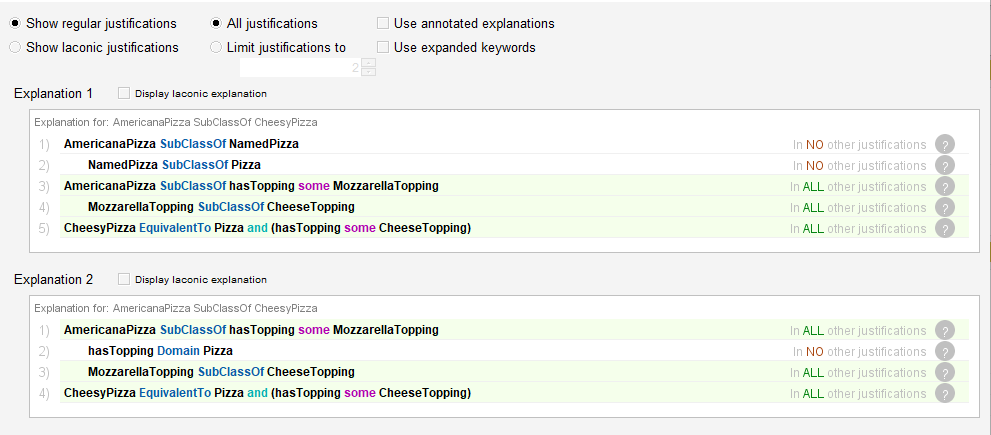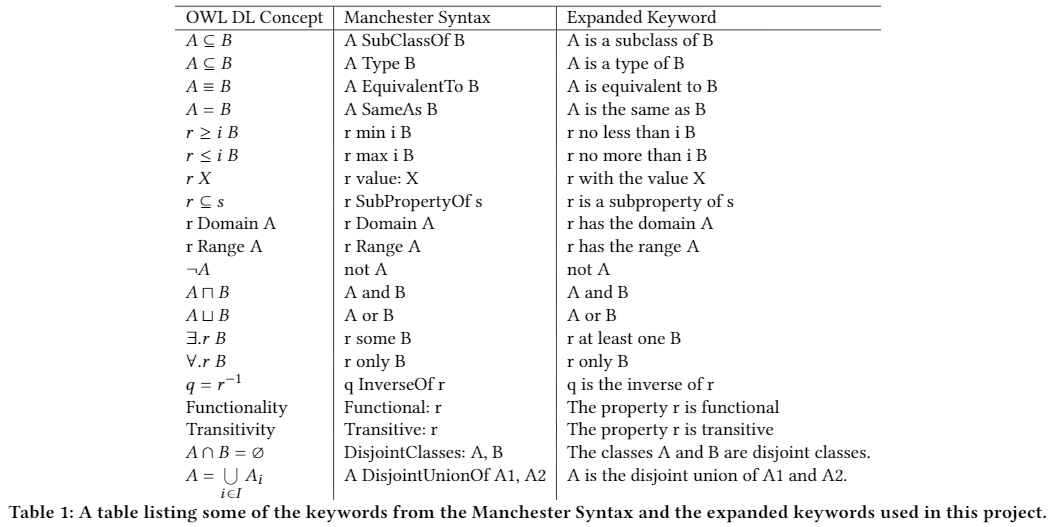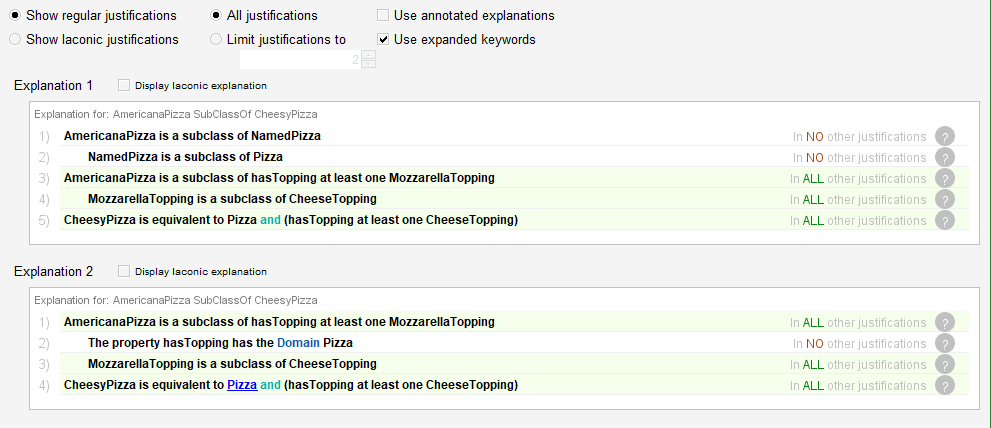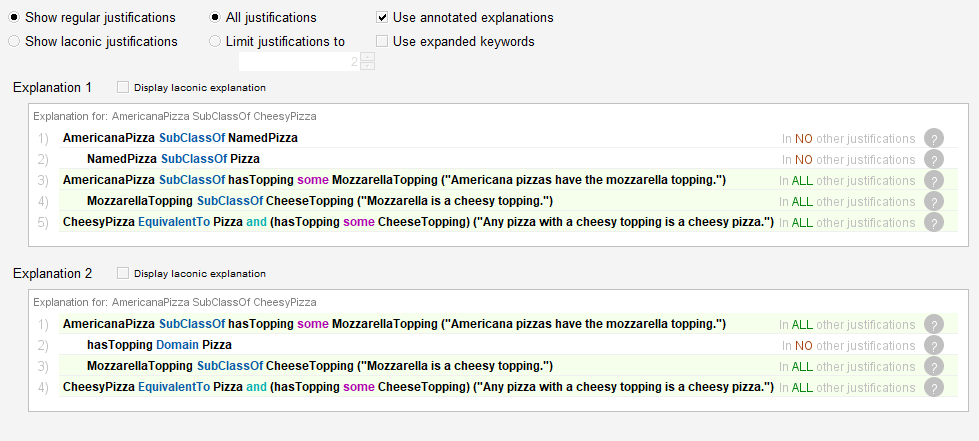
Improved Explanations in the Protégé OWL Ontology Editor

Introduction
This paper gives a light overview of the theory behind description logics and explanations, followed by an overview of OWL and Protégé, before covering this project's aims and results.
Description Logics
Description Logics are a family of knowledge-representation languages that are often used to create ontologies. Ontologies are the knowledge bases for logic-based reasoning systems. As explained on the home page, explanations are a key part of these systems and their use.
Explanations
Explanations result in increased user acceptance of a system's recommendations. Novice users solve problems faster and more accurately when explanations are available. There are several types of explanations, and Clancey provided a detailed epistemology for explanations in 1983. For this paper, we will only focus on Justification explanations.
Justification Explanations
Explanations that explain why a certain result is obtained.
Justifications
A justification is a set of axioms defined as the smallest subset of the ontology such that an entailment still holds. In other words, it is all the axioms in an ontology that lead to some result. Justifications are used since they are relatively simple to calculate and provide a clear link to the knowledge base.
This link to the knowledge base is useful in several of the evaluation criteria as provided by Swartout and Moore, which we mention on the home page.
The Web Ontology Language (OWL)
OWL is an ontology language developed for the Semantic Web and is the language used by Protégé.
Characteristics of OWL
OWL is a description logic in the ALC DL language family, which is explained in detail on the theory page. For our purposes here, it is sufficient to know that OWL has classes, instances of classes, and relations between classes, referred to as classes, objects, and properties respectively.
OWL axioms have several constructors, such as negation, conjunction, value and existential restrictions. Again, the theory page has a detailed description of these. OWL also has annotations that can be added to any OWL object. These are often used as comments and to provide metadata to objects.
Manchester Syntax
Of interest to this paper is the Manchester Syntax for OWL. This is a mapping of the normal OWL syntax to something that is more natural language and "less logician-like", developed by Horridge et al. Protégé uses this syntax and its users were the catalysts for the development of the Manchester Syntax.
Protégé
Protégé is a popular ontology editor developed by the Stanford Center for Biomedical Informatics Research at the Stanford University School of Medicine. A very useful tutorial to using Protégé can be found here.
Protégé OWL Ontology Editor
Protégé uses the OWL description logic as its language. It was developed with modularity in mind, thus much of its functionality is contained in plugins. There are plugins for several reasoners, such as the HermiT and FaCT++ reasoners. Plugins also exist for graphical visualization of ontologies, among many others.
Explanation Workbench
A standard plugin bundled with the Protégé download is the Explanation Workbench developed by Horridge et al. This plugin provides justification explanations for axioms in an OWL ontology. It uses both glass-box and black-box algorithms to calculate the justifications with the plugin interface provided by Protégé.
It displays the justifications in the form of a list of axioms. These axioms are ranked and ordered using algorithms developed by Horridge and displayed in the 'thought-process' order of the reasoner. However, these axioms require an understanding of description logics and OWL to be understood, which makes the explanations inaccessible to novice users.
Improvements made
We improved the base explanations by expanding the keywords of the Manchester Syntax as used in the justification's axioms. We also provided the ability for ontology creators to define an explanation for a particular axiom. The user can choose between expanded keywords, explanatory annotations, or both options at the same time.
Expanded keywords
The keywords of the Manchester Syntax are difficult to understand if the reader does not have an understanding of description logics or OWL. Hence, we replaced them with phrases that carry the same meaning, but are easier to understand and less reliant on an understanding of description logics. Some of the expansions are provided in the table below. We also show Protégé in operation with the expanded keywords in the explanations.
Annotated Explanations
Using the annotation framework provided by the OWL language, we allow for ontology creators to define an explanation for an axiom. This annotation property is defined in the OWL framework by this paper as
<owl:AnnotationProperty rdf:about="exp:Explanation"/>.
When the justification is displayed, the program iterates through all annotations of each axiom. If an annotation is of the type exp:Explanation, the axiom is displayed with the explanatory annotation appended to it, as seen in the image below.
If no annotation of type exp:Explanation is found, the program will display it as normal based on user choices.
Further work
There is a lot of further work that can be done using this paper as a baseline.
Generating annotations
At the moment, the explanatory annotations need to be defined by the ontology creator. However, with many older and larger ontologies, it will take a very long time to go back and add explanatory annotations to all the important axioms. Thus, automatically generated annotations will be of great use. A logical direction for this type of research would be a formally acknowledged definition for an explanatory annotation.
If such a tool is created, it could take inspiration from the SWAT Ontology Editor and the OWL Simplified English used by that editor. The ordering and prioritisation of axioms as done by Horridge might also be of use to determine what axioms should get annotations.
Further research can also be done to integrate the keyword expansion and the OWL Simplified English syntax. This can be integrated with user testing to evaluate the various attempts at natural language expressions for OWL and the associated explanations.
Acknowledgements
This paper could not have succeeded without the assistance and contributions of several people.
Firstly, much gratitude is due Professor Tommie Meyer, project supervisor, for not only providing the basic framework and topic of the project but doing his best to find a project focus that is of interest to me. Thanks to Victoria Chama for her assistance in the early research phases, and Solomon Malesa for being a willing project partner to bounce ideas from and helping with understanding the abstract theory.
 A screenshot of a Protégé explanation as provided by the default Explanation Workbench.
A screenshot of a Protégé explanation as provided by the default Explanation Workbench.

 A screenshot of a Protégé explanation with the keywords in the axioms expanded.
A screenshot of a Protégé explanation with the keywords in the axioms expanded.
 A screenshot of a Protégé explanation with annotated explanations for some of the axioms.
A screenshot of a Protégé explanation with annotated explanations for some of the axioms.